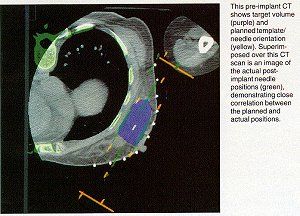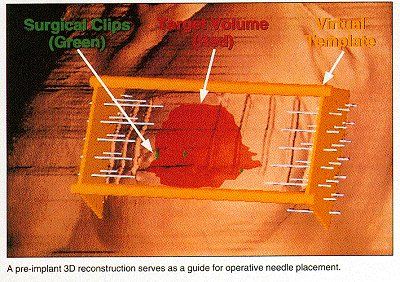Brachytherapy to Tumor Bed After Lumpectomy a Possible Alternative to External Beam Therapy
ROYAL OAK, Mich-Interstitial implants that deliver radiation therapy to the tumor bed alone after lumpectomy have been well tolerated with no significant acute or late toxicity in the first 50 patients in a Michigan study. In addition, with three years' median follow-up, no patients have recurred locally or distantly.
ROYAL OAK, MichInterstitial implants that deliver radiation therapyto the tumor bed alone after lumpectomy have been well tolerated with nosignificant acute or late toxicity in the first 50 patients in a Michiganstudy. In addition, with three years' median follow-up, no patients haverecurred locally or distantly.
"It's still early, but we're quite encouraged with the resultsso far," Vinay Sharma, MD, a brachytherapy fellow at William BeaumontHospital, said at a poster presentation of the study, which was conductedby Frank Vicini, MD, and colleagues. [See page 10 for a report on intraoperativeexternal beam radiation in this setting.]

The pilot study, begun in March 1993, includes selected patients withearly-stage breast cancer treated with breast-conserving therapy. Eligiblepatients had tumors less than 3 cm, margins clear by 2 mm, no extensiveintraductal component, a breast technically suitable for implant, and threeor fewer involved nodes.
Implants Loaded into Catheters
Patients received a 50 Gy dose to the tumor bed over a 96-hour period.The implants, radioactive iodine 125 seeds, are loaded into catheters placedwithin the breast. About 30% of the time, the implants are placed at thetime of re-excision. "In that setting, the tumor cavity is open andwe see exactly where we're putting our needles," Dr. Sharma said.
The other 70% of the time, he said, seed implantation is done as a separateoperation or at the time of an axillary lymph node dissection "andthen we're dealing with a closed cavity."
In these cases, the researchers use three-dimensional (3D) computedtomography and ultrasound computer reconstructions to help guide theirplacement of the needles.

The researchers conclude that the brachytherapy technique may providea safe, quick, and effective alternative to standard external beam radiationtherapy.
The implant method significantly decreases patient inconvenience andreduces delays in the initiation of systemic therapy, Dr. Sharma said.He noted, however, that longer follow-up will be needed to establish whetherthis approach is equivalent in efficacy to that of standard post-lumpectomyexternal beam radiation therapy.